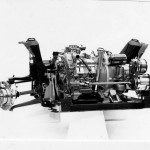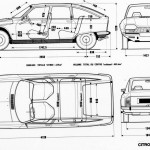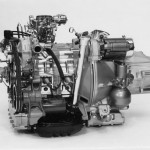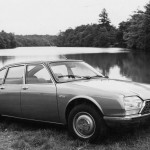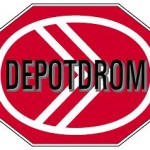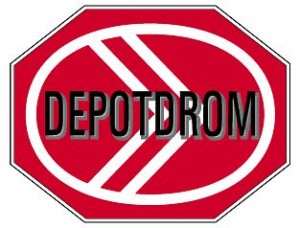
(English below)
Vor 40 Jahre, im Herbst 1973, präsentierte Citroën auf der Internationalen Automobil-Ausstellung in Frankfurt den Citroën GS Birotor. Der Zweischeiben-Wankelmotor bot im Vergleich zur herkömmlichen Motorisierung des Citroën GS dank einer außergewöhnlichen Laufruhe und Drehfreude ein völlig neues Fahrgefühl.
Der perfekt ausgewuchtete Birotor verfügte über keinerlei Vibrationen, daher war auch sein Geräuschpegel bis in die höchsten Drehzahlbereiche extrem niedrig. Der wassergekühlte Zweischeiben-Wankelmotor war mit acht Hauptelementen vergleichsweise einfach aufgebaut: Neben zwei Trachoiden und einem Zwischenteil zur Trennung der beiden Trachoiden verfügte der Birotor über zwei Seitenteile vorne und hinten, zwei Kreis-Kolben, auch Rotor genannt, sowie die Motorwelle mit zwei Exzentern.
Das Viertaktsystem funktionierte ohne Ventile, Federn, Kipphebel, Stangen oder Nockenwellen. Im ersten Takt drang das Kraftstoff-Luftgemisch durch den Ansaugkanal ein. Der Kolben verschloss im zweiten Takt die Einlassöffnung und verdichtete somit das Gemisch. Die durch die Zündkerzen erzeugten Funken zündeten das Kraftstoff-Luft-Gemisch in dem Moment, in dem der Verdichtungsdruck maximal war. Die Expansion versetzte im dritten Takt den Kolben in Drehung und lieferte dank der auf die Kolbenfläche ausgeübten Druckkräfte die notwendige Antriebsenergie. Im vierten und letzten Takt gab der Kolben die Auslassöffnung frei, so dass die verbrannten Gase ausströmen konnten.
Die Produktion des Zweischeiben-Wankelmotors Birotor Typ 624 basiert auf einer Kooperation mit der Firma Comotor S.A., einem Gemeinschaftsunternehmen von Citroën und NSU. Zwischen März 1974 und März 1975 wurden insgesamt gerade einmal 847 Citroën GS Birotor im Motorenwerk in Altfortweiler an der Saar hergestellt.
Eine geänderte Marktsituation sorgte für das frühe Aus des Birotors: Aufgrund der Energiekrise Mitte der 1970er Jahre wurde der für Deutschland geplante Verkauf des Citroën GS Birotor zum Preis von 14.500 D-Mark noch vor dem Verkaufsstart gestoppt, da dem Motor bei einem durchschnittlichen Verbrauch von rund 14 l/100 km keine guten Marktchancen eingeräumt wurden.
Der Citroën GS Birotor auf einen Blick
* Internationale Vorstellung Herbst 1973 auf der IAA in Frankfurt
* Produktionszeitraum: 1974 bis 1975
* Produzierte Fahrzeuge mit Birotor: 847
* Leistung: 107 DIN PS (78,8 kW) bei 6.500 U/min
* Max. Drehmoment: 14m/kg bei 3.000 U/min
* Hubraum: 2 x 497,5 cm3 Kammervolumen (nach Steuerformel 1.990 cm3)
* DIN-Verbrauch: 14,08 L/100km
* Max. Geschwindigkeit: 175 km/h
* Beschleunigung 0-100km/h: 14 Sekunden
Der Download: Pressemitteilung der Citroën Deutschland GmbH: 40 Jahre GS Birotor.
Wir empfehlen, sich bei Fragen rund um die Technik, Ersatzteile und Expertenwissen an die deutschen Citroën-Clubs zu wenden.
—–
40 Years of Citroën GS Birotor
Citroën Deutschland GmbH has released a press information today:
“…40 years ago, in the fall of 1973, Citroën unveiled at the International Motor Show in Frankfurt, the Citroën GS with two rotors. The two-rotor Wankel engine offered in comparison to the conventional engine of the Citroën GS an outstanding modesty and allowed a completely new driving experience.
The perfectly balanced rotary engine with two rotors had no vibrations, hence its noise level up to the highest speed ranges was extremely low. The water-cooled two-rotor Wankel engine was comparatively simply structured with eight main elements: In addition to two trachoides and an intermediate portion for separating the two trachoides, the two rotors had two side panels front and rear, two circular pistons, also called the rotor, and the motor shaft with two eccentrics.
The four-stroke system worked without valves, springs, rockers, rods or camshafts. In the first cycle, the fuel-air mixture penetrated through the intake. The piston locked in the second cycle, the inlet opening and thus the compressed mixture. The sparks generated by the spark ignited the fuel-air mixture in the moment in which the compaction pressure was maximum. The offset in the third expansion stroke the piston in rotation and provided thanks to the force applied to the piston surface pressure forces the necessary operating power. The fourth and final stroke, the piston released the outlet so that the burned gases could flow out.
The production of the two-rotor Wankel engine Type 624 is based on a cooperation with the company comotor SA, a joint venture between Citroën and NSU. Between March 1974 and March 1975 a total of just 847 Citroën GS with two rotors were produced at the engine plant in Altfortweiler on the Saar.
A changed market situation made for the early end of the Birotors: Due to the energy crisis of the mid 1970s, the planned for Germany selling the Citroën GS with two rotors for the price of 14,500 Deutsche Mark was stopped before the launch because the engine at an average consumption of around 14 l/100 km were given no good market opportunities.
The Citroën GS with two rotors at a glance
* International Launch the fall of 1973 at the IAA in Frankfurt
* Production period: 1974-1975
* Produced vehicles: 847
* Power: 107 DIN hp ( 78.8 kW) at 6,500 rev / min
* Max torque : 14m/kg at 3,000 rev / min
* Capacity: 2 x 497.5 cm3 chamber volume (tax 1.990 cm3)
* DIN consumption : 14.08 L/100km
* Maximum speed: 175 km/h
* Acceleration 0 -100km/h: 14 seconds


